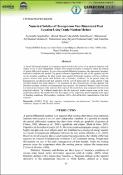Options
Numerical Solution of Homogeneous One-Dimensional Heat Equation Using Crank-Nicolson Method
Date Issued
2021-02-18
Author(s)
Faizzuddin Jamaluddin
Ahmad Danial Hidayatullah Badrolhisam
Muhammad Arif Hannan Mohamed
Muhammad Aniq Qayyum Mohamad Sukry
Norazlina Subani
Abstract
A partial differential equation is an equation which includes derivatives of an unknown function with respect to two or more independent variables. The numerical solution is needed to obtain the solution of partial differential equation. To solve these partial differential equations, the appropriate boundary and initial conditions are needed. The general solution is dependent not only on the equation, but also on the boundary conditions. In other words, these partial differential equations will have different general solution when paired with different sets of boundary conditions. In the present study, the homogeneous one-dimensional heat equation will be solved numerically by using Implicit Crank Nicolson method. Our main objective is to determine the flow characteristics of heat equation with Dirichlet boundary condition on homogeneous heat equation. The method of Implicit Crank Nicolson has been chosen because of the stability of the method. The results have been compared with the exact analytical solution. The validated results show that the numerical results remains same as the exact analytical solutions. The results show that the changes of the temperature profile depends on the types of boundary conditions. The boundary conditions will be affected the flow characteristics of the heat equation.
Subjects
File(s)
Loading...
Name
Numerical Solution of Homogeneous One-Dimensional Heat Equation Using Crank-Nicolson Method.pdf
Size
721.84 KB
Format
Adobe PDF
Checksum
(MD5):dffb2f17a81a11397cc66fb07bab66ac